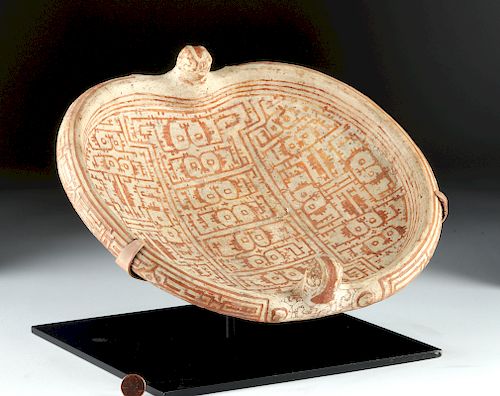Marajoara Dish - Maze of Owls, Bat Guardians
Lot 293
About Seller
Artemis Gallery
686 S Taylor Ave, Ste 106
Louisville, CO 80027
United States
Selling antiquities, ancient and ethnographic art online since 1993, Artemis Gallery specializes in Classical Antiquities (Egyptian, Greek, Roman, Near Eastern), Asian, Pre-Columbian, African / Tribal / Oceanographic art. Our extensive inventory includes pottery, stone, metal, wood, glass and textil...Read more
Estimate:
$4,500 - $6,750
Absentee vs Live bid
Two ways to bid:
- Leave a max absentee bid and the platform will bid on your behalf up to your maximum bid during the live auction.
- Bid live during the auction and your bids will be submitted real-time to the auctioneer.
Bid Increments
| Price | Bid Increment |
|---|---|
| $0 | $25 |
| $300 | $50 |
| $1,000 | $100 |
| $2,000 | $250 |
| $5,000 | $500 |
| $10,000 | $1,000 |
| $20,000 | $2,500 |
| $50,000 | $5,000 |
| $100,000 | $10,000 |
| $200,000 | $20,000 |
About Auction
By Artemis Gallery
Jan 7, 2020
Set Reminder
2020-01-07 10:00:00
2020-01-07 10:00:00
America/New_York
Bidsquare
Bidsquare : VARIETY AUCTION - Antiquities / Ethnographic
https://www.bidsquare.com/auctions/artemis-gallery/variety-auction---antiquities-ethnographic-4787
Around the world & back in time - be amazed at the treasures you will find. Antiquities from Egypt, Greece, Italy and the Near East, Asian, Pre-Columbian, African / Tribal / Oceanic, Native American, Spanish Colonial, Russian Icons, Fine Art, much more! Artemis Gallery info@artemisgallery.com
Around the world & back in time - be amazed at the treasures you will find. Antiquities from Egypt, Greece, Italy and the Near East, Asian, Pre-Columbian, African / Tribal / Oceanic, Native American, Spanish Colonial, Russian Icons, Fine Art, much more! Artemis Gallery info@artemisgallery.com
- Lot Description
**Originally Listed At $3000**
Pre-Columbian, Lower Amazon Basin, Marajo Island, Brazil, ca. 800 to 1400 CE. A lovely hand-built ceramic dish decorated in a bichrome red-on-cream iconographic/decorative program - featuring a mesmerizing maze of owl effigy figures with wings and talons emerging from their heads in an abstract manner surrounded by a repeated linear border. The thick, rounded rim is decorated with incised and painted geometric motifs, and it is slightly indented at opposite ends where twin handles emerge in the form of bat heads protruding in extremely high relief. Such dishes were used for ceremonial offerings, and the overall shape of the vessel suggests a turtle form. The elaborate decorative program is akin to a labyrinth pattern, which is a hallmark of Marajoara ceremonial vessels. This in addition to the wondrous zoomorphic iconography designates this as a particularly special dish. Size: 12.5" W x 11.375" H (31.8 cm x 28.9 cm); 9.75" H (24.8 cm) on included custom stand.
Among the most masterfully painted Marajoaran dishes we have ever handled, this piece with its magical maze comprised of two columns of owl people/figures bordering a central column of owl masks - all with extending limbs and wings and guarded by a pair of bat-like high relief handles - is impressive not only for its style and technique, but also for its meaningful iconography. In the Pre-Columbian world, owls and bats - both nocturnal animals - were believed to be guardians in the afterlife. What's more, swooping and darting bats of the ominous nocturnal world were also associated with rain, fertility, and maize production. Finally, given the overall turtle like form, it is important to understand that in the Pre-Columbian world, turtle imagery represented the watery surface separating the sky from the underworld. In addition to its earth metaphor, turtles were also symbols of fertility.
Marajo Island - the largest river island of the world - is located at the mouths of the Amazon and Tocantins Rivers in Brazil. The indigenous of Marajo developed what is generally regarded as the oldest ceramic artform in Brazil - indeed among the oldest forms of the Americas. Numerous decorative traditions and techniques developed over time. Beginning with the Ananatubas, the oldest potters of the island dating from the 1st millennium BCE, several unique ceramic traditions emerged; however, what is known as the Marajoara polychrome phase existed from about 400 to 1350 CE. As we see in this example, these ceramics possess striking color palettes and an impressive diversity in technique and decoration that had never been seen before. In fact, the Marajoaran potters used about fifteen finishing techniques - featuring fine carving, modeled sculptural details, lush red and white washes, incision, excision, and polychrome painting.
For a similar example, see "O Museu Paraense Emilio Goeldi", Banco Safra, 1986, p. 133.
Provenance: ex-Eugene Lions collection, Geneve, Switzerland, collected 1960-2000
All items legal to buy/sell under U.S. Statute covering cultural patrimony Code 2600, CHAPTER 14, and are guaranteed to be as described or your money back.
A Certificate of Authenticity will accompany all winning bids.
We ship worldwide and handle all shipping in-house for your convenience.
#133777A few surface fissures and expected crazing to the slip. Normal surface wear with scuffs and abraded areas, but the painted program is very well preserved.Condition
- Shipping Info
-
All shipping is handled in-house for your convenience. Your invoice from Artemis Gallery will include shipping calculation instructions. If in doubt, please inquire BEFORE bidding for estimated shipping costs for individual items.
-
- Buyer's Premium



 EUR
EUR CAD
CAD AUD
AUD GBP
GBP MXN
MXN HKD
HKD CNY
CNY MYR
MYR SEK
SEK SGD
SGD CHF
CHF THB
THB















